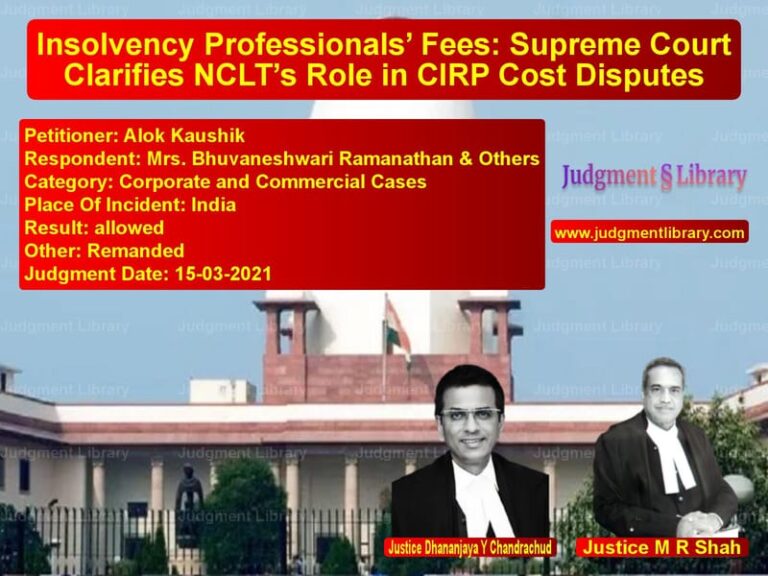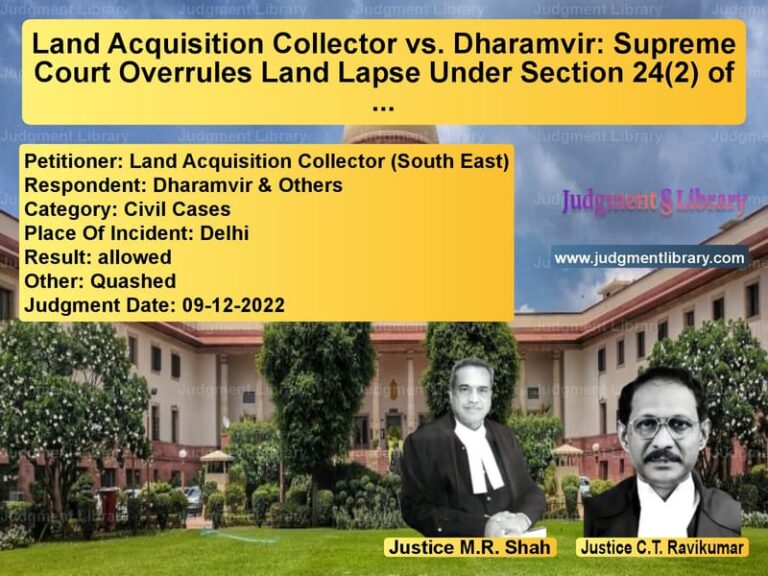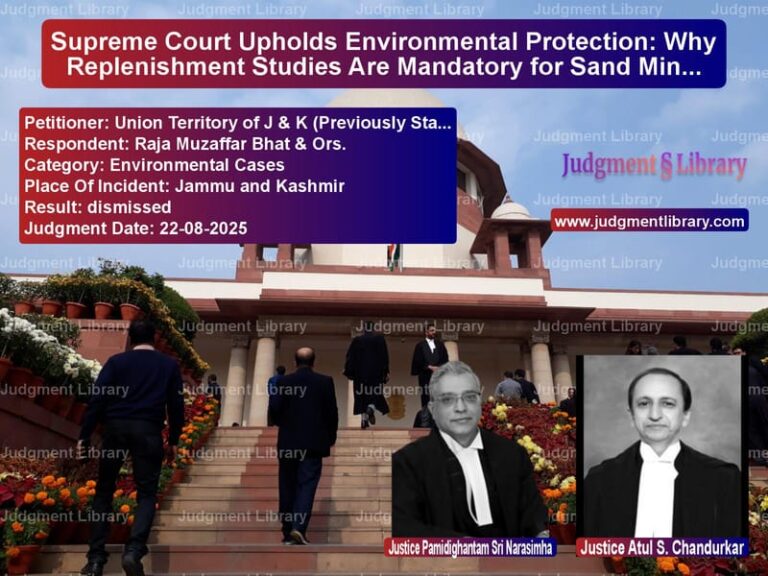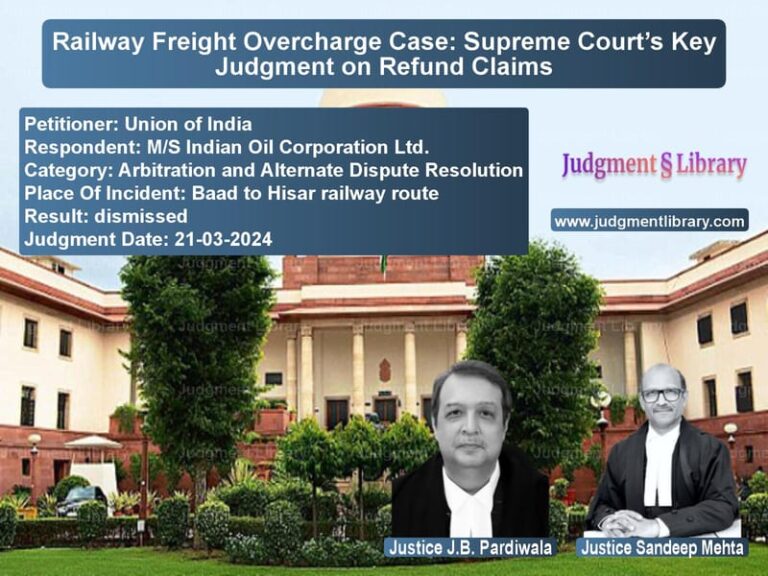Regularization of Fast Track Court Judges: Supreme Court Rules on Judicial Appointments
The Supreme Court of India, in the case of High Court of Hyderabad vs. P. Murali Mohana Reddy & Others, addressed a crucial issue concerning the regularization of Adhoc Fast Track Court (FTC) judges appointed from the Bar in the erstwhile State of Andhra Pradesh (now bifurcated into Telangana and Andhra Pradesh). The case revolved around the selection criteria for absorbing these judges into the regular cadre of the State Judicial Service.
The dispute arose when the High Court of Hyderabad denied regularization to certain FTC judges on the ground that they failed to secure qualifying marks in the viva voce test and in the aggregate of the written and oral examination. The affected judges challenged this decision, leading to a judicial review of the selection process.
Background of the Case
The appointment of FTC judges was an initiative of the Indian judiciary to clear pending cases and improve judicial efficiency. In compliance with the Supreme Court’s ruling in Brij Mohan Lal vs. Union of India & Others, the Andhra Pradesh government appointed 20 advocates as Adhoc Fast Track Court District Judges in 2003.
As per the directives of the Supreme Court in Brij Mohan Lal, a screening process was mandated for the absorption of FTC judges into the regular cadre. The examination structure included:
- A written examination (150 marks).
- A viva voce (oral interview) test (100 marks).
- A provision for awarding one mark per year of service in the FTCs.
- Minimum qualifying marks: 40% aggregate for general candidates and 35% for SC/ST/OBC candidates.
The selection process was conducted by the High Court of Hyderabad, which ultimately selected 12 out of the 19 candidates who appeared for the test. Seven candidates, including the respondents, were not selected as they did not secure the qualifying marks in the viva voce or in the aggregate.
Petitioner’s Arguments (High Court of Hyderabad)
- The selection process adhered to the guidelines laid down in Brij Mohan Lal, and the candidates who did not meet the qualifying marks criteria could not be absorbed.
- The selection criteria, including the requirement for minimum qualifying marks in viva voce and the aggregate, were based on the judicial directives of the Supreme Court.
- Revising the selection criteria post hoc would be unfair to the candidates who qualified under the existing parameters.
Respondent’s Arguments (P. Murali Mohana Reddy & Others)
- The advertisement for the selection process did not mention any requirement for minimum qualifying marks in the viva voce test.
- The selection committee unilaterally introduced the qualifying marks for viva voce, which was in violation of the existing recruitment rules.
- As per Rule 6 of the Andhra Pradesh Judicial Services Rules, there was no provision mandating qualifying marks for the viva voce.
Supreme Court’s Judgment
The Supreme Court, led by Justices A.K. Sikri and S. Abdul Nazeer, ruled partially in favor of the respondents, affirming that:
- Non-Existence of Minimum Qualifying Marks in Viva Voce: The Court observed that neither the advertisement nor Rule 6 of the Andhra Pradesh Judicial Services Rules prescribed minimum qualifying marks for the viva voce test.
- Adherence to Aggregate Qualifying Marks: The Court, however, upheld that candidates must secure the prescribed aggregate marks (40% for general and 35% for SC/ST/OBC) to qualify.
- Relief for Two Candidates: The Court exercised its discretion under Article 142 of the Constitution and directed that two candidates—who marginally missed the required aggregate by less than one mark—be deemed to have qualified.
- Re-Examination for Remaining Candidates: The Court directed that the remaining two candidates, who had failed to meet the aggregate marks requirement, be given another opportunity to take the written examination and viva voce.
Observations from the Judgment
The Court referred to established precedents, including Umesh Chandra Shukla vs. Union of India, holding that:
“The selection criteria must be transparent, and any additional conditions must be explicitly stated in the advertisement. Post-facto changes in selection parameters are impermissible.”
The Court further noted:
“Since the process of selection was meant for the absorption of FTC judges with years of judicial experience, the criteria should have been framed accordingly, considering their service in the judiciary.”
Conclusion
The Supreme Court’s judgment upholds the principles of fairness in judicial appointments while ensuring compliance with prescribed guidelines. It sets an important precedent that selection criteria must be clearly defined at the outset and cannot be altered post-selection.
Petitioner Name: High Court of Hyderabad.Respondent Name: P. Murali Mohana Reddy & Others.Judgment By: Justice A.K. Sikri, Justice S. Abdul Nazeer.Place Of Incident: Andhra Pradesh and Telangana.Judgment Date: 25-01-2019.
Don’t miss out on the full details! Download the complete judgment in PDF format below and gain valuable insights instantly!
Download Judgment: High Court of Hydera vs P. Murali Mohana Red Supreme Court of India Judgment Dated 25-01-2019.pdf
Direct Downlaod Judgment: Direct downlaod this Judgment
See all petitions in Employment Disputes
See all petitions in Recruitment Policies
See all petitions in Public Sector Employees
See all petitions in Judgment by A.K. Sikri
See all petitions in Judgment by S. Abdul Nazeer
See all petitions in partially allowed
See all petitions in Modified
See all petitions in supreme court of India judgments January 2019
See all petitions in 2019 judgments
See all posts in Service Matters Category
See all allowed petitions in Service Matters Category
See all Dismissed petitions in Service Matters Category
See all partially allowed petitions in Service Matters Category







